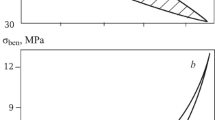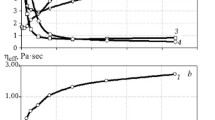The efficiency of insignificant additions of clay and kaolin in relation to the production of molded and unmolded ceramic concretes, based on the use of HCBS of silica, aluminosilicate, high-alumina and corundum compositions, is shown. These additions can be made both as part of HCBS and in molding systems in the manufacture of ceramic concrete. Clay additives are especially effective in the manufacture of monolithic linings based on the Al2O3–SiO2–SiC–C system by vibro-pneumatic ramming. By introducing additives, it is possible to improve the rheotechnological properties of both initial HCBS of various compositions and matrix systems of ceramic concretes formed by various methods.











Similar content being viewed by others
References
Yu. E. Pivinskii, V. A. Doroganov, and E. A. Doroganov, “cement-free refractory concretes. Part 6. Comparative evaluation of natural (clay) and artificial ceramic binders (HCBS),” Novye Ogneupory, No. 9, 25 – 31 (2020).
Yu. E. Pivinskii, Ceramic and Refractory Materials in 2 Vol [in Russian], Stroiizdat, St. Petersburg (2003).
Yu. E. Pivinskii, Rheology of Dispersed System HCBS and ceramicConcretes. Elements of nanotechnology in Silicate materials Science in 3 Vol, Politekhnika, St. Petersburg (2012).
E. M. Grishpun, Yu. E. Pivinskii, E. V. Rozhkov, et al., “Production and service of high-alumina ceramic castables. 1. Ramming mixtures based on modified bauxite HCBS,” Refract. Ind. Ceram., 41(3/4), 104 – 108 (2000).
E. V. Rozhkov, Yu. E. Pivinskii, M. Z. Naginskii, et al., “Production and service of high-alumina ceramic castables. 2. Properties and service of vibration-placed castables based on bauxite-modified highly concentrated binding suspensions (HCBS) for use in blast-furnace runners,” Refract. Ind. Ceram., 52(5/6), 209 – 216 (2001).
E. M. Grishpun, L. A. Gorokhovskii, A. M. Karpets, et al., “Prospects for producing and exploiting new forms of OAO Dinur refractories,” Novye Ogneupory, No. 4, 100 – 102 (2004).
A. M. Gorokhovskii and E. V. Beklemyshev, “Unmolded refractories produced by OAO Dinur,” Novye Ogneupory, No. 11, 15 – 21 (2014).
Yu. E. Pivinskii, E. M. Grishpun, and A. M. Gorokhovskii, “Engineering, manufacturing and servicing of shaped and unshaped refractories based on highly concentrated ceramic binding suspensions,” Refract. Ind. Ceram., 56(3), 245 – 253 (2015).
E. M. Grishpun and Yu. E. Pivinskii, “twenty year epoch of cooperation,” Novye Ogneupory, No. 1, 15 – 25 (2007).
E. M. Grishpun and Yu. E. Pivinskii, “HCBS and ceramic concretes – technology breakthrough for XXI century refractories,” Novye Ogneupory, No. 28 (2002).
P. V. Dyakin, Yu. E. Pivinskii, D. S. Prokorenkov, and V. A. Doroganov, “Phase composition, structure and some properties of materials based on Bauxite HCBS of composite composition in the Al2O0–SiO2–SiC system,” Vestn. V. G. Shukov BGTU, No. 2, 115 – 125 (2020).
Yu. E. Pivinskii, “Cement-free refractory concretes. Part 1. General information. HCBS and ceramic concretes,” Refract. Ind. Ceram., 60(5), 430 – 438 (2019).
Yu. E. Pivinskii, P. V. Dyakin, E. M. Grishpun, et al., “Cement-free refractory concretes. Part 2. High-alumina and corundum ceramic concretes,” Refract. Ind. Ceram., 60(6), 566 – 573 (2019).
Yu. E. Pivinskii and A. I. Natsenko, “Rheological and technological properties of mixed suspensions of refractory components,” Refractories, 15(11/12), 710 – 716 (1974).
Yu. E. Pivinskii and M. A. Trubitsyn, “Refractory concretes of new generation. General characteristics of the binder systems,” Refractories, 3(11), 673 – 681 (1990).
Yu. E. Pivinskii and A. V. Cherevatova, “Materials based on highly concentrated ceramic binding suspensions (HCBS). 3. Properties of mixed binders in the system of quartz sand HCBS and refractory clay,” Refract. Ind. Ceram., 38(7/8), 315 – 319 (1997).
Yu. E. Pivinskii and A. V. Cherevatova, “Materials based on highly concentrated ceramic binding suspensions (HCBS). Study and comparative evaluation of methods for molding silica ceramic concretes,” Refract. Ind. Ceram., 38(9/10), 374 – 379 (1997).
Yu. E. Pivinskii and A. V. Cherevatova, “Materials based on highly concentrated ceramic binding suspensions (HCBS). The effect of heat treatment temperature on the strength properties of siliceous ceramic castables,” Refract. Ind. Ceram., 39(7/8), 231 – 236 (1998).
Yu. E. Pivinskii, P. V. Dyakin, S. V. Vikhman, et al., “Press-Molding of high-alumina ceramic castables. 1. Compaction and properties of matrix systems based on mixed HCBS of composition: bauxite, quartz glass, and commercial alumina,” Refract. Ind. Ceram., 46(3), 220 – 224 (2005).
Yu. E. Pivinskii, P. V. Dyakin, S. V. Vikhman, et al., “Pressure-molded high-alumina ceramic castables. 2. Compaction and properties of materials based on plasticized bauxite HCBS, reactive alumina, and their binary mixtures,” Refract. Ind. Ceram., 46(6), 396 – 402 (2005).
Yu. E. Pivinskii and V. Yu. Belousova, “Materials based on highly concentrated ceramic binding suspensions (HCBS). Corundum and corundum-mullite ceramic castables based on plasticized HCBS of bauxite,” Refract. Ind. Ceram., 40(9/10), 391 – 395 (1999).
R. Ya. Popil’skii and Yu. E. Pivinskii, Compaction of Powder ceramic Mixes [in Russian], Metallurgiya, Moscow (1983).
Yu. E. Pivinskii and P. V. Dyakin, “Preparation and properties of corundum HCBS and ceramic concretes. Part 1. Mixed HCBS in the system electrocorundum — very fine quartz glass,” Refract. Ind. Ceram., 51(1), 25 – 31 (2010).
Yu. E. Pivinskii and P. V. Dyakin, “Preparation and properties of corundum HCBS and ceramic concretes. Part 2. Composition and properties of compacted ceramic concretes,” Refract. Ind. Ceram., 51(1), 32 – 38 (2010).
Yu. E. Pivinskii, Pavel V. Dyakin, and Petr V. Dyakin, “Study of compaction high-alumina ceramoconcretes. 4. The effect of firing temperature on the properties of a matrix system and on ceramoconcrete,” Refract. Ind. Ceram., 47(5), 302 – 309 (2006).
Yu. E. Pivinskii, V. A. Doroganov, and E. A. Doroganov, “Refractory plastic mixtures based on highly concentrated ceramic binding suspensions (HCBS). 1. Structural and mechanical properties of suspensions (pastes) of refractory clays,” Refract. Ind. Ceram., 41(3/4), 125 – 130 (2000).
V. A. Doroganov, Yu. E. Pivinskii, and E. A. Doroganov, “Refractory plastic masses based on highly concentrated ceramic binding suspensions (HCBS). II. Structural and mechanical properties of plasticized HCBS in the system SiO2 – clay,” Refract. Ind. Ceram., 42(3/4), 106 – 110 (2001).
V. A. Doroganov and Yu. E. Pivinskii, “Refractory plastic masses based on highly concentrated ceramic binding suspensions (HCBS). III. Structural-mechanical properties of plasticized masses based on bauxite HCBS and characterization of materials derived from them,” Refract. Ind. Ceram., 42(3/4), 151 – 156 (2001).
V. A. Doroganov and E. I. Evtushenko, Refractory Ceramic Concretes: Monograph, LABLAMBERT Academic Publishing GmbH & Co. KG, Saarbrucken (2011).
E. V. Neverova, V. A. Doroganov, and S. Stankovich, “Study of artificial binders based on silicate materials for ceramic production,” Stroit. Mater. Izdeliya, 1(3), 11 – 16 (2018).
Work was conducted within the scope of a program for development of university support based on the V. G. Shukov BGTU.
Author information
Authors and Affiliations
Corresponding author
Additional information
Translated from Novye Ogneupory, No. 10, pp. 18 – 26, October, 2020.
Rights and permissions
About this article
Cite this article
Pivinskii, Y.E., Doroganov, V.A., Doroganov, E.A. et al. Efficiency of Refractory Clay Additions in Ceramic Concrete Technology (Review Article). Refract Ind Ceram 61, 560–567 (2021). https://doi.org/10.1007/s11148-021-00521-8
Published:
Issue Date:
DOI: https://doi.org/10.1007/s11148-021-00521-8




